Ariel S. Winter's Blog
April 11, 2016
BARREN COVE AVAILABLE APRIL 26, 2016
 IT HAS BEEN LONG ENOUGH SINCE I last posted on We Too Were Children that I have to admit the blog is defunct. There are still a lot of books I want to highlight, but the amount of work each post takes has become prohibitive. Hopefully, a time will come when I can revive the blog or find other ways to get out new material.
IT HAS BEEN LONG ENOUGH SINCE I last posted on We Too Were Children that I have to admit the blog is defunct. There are still a lot of books I want to highlight, but the amount of work each post takes has become prohibitive. Hopefully, a time will come when I can revive the blog or find other ways to get out new material.One last product of We Too Were Children is my article on Ken Kesey's lost novel Tales of Grandma Whittier, which appeared in Slice Magazine Issue 17. I started to do a series on Kesey's children's books for the blog, and discovered that he had self-published an unfinished serial novel. That discovery led to months of research that culminated in the article, so that article can be considered the final publication of We Too Were Children, Mr. Barrie. Please click through to Slice's website to find out how you can get a copy of the magazine.
My new novel BARREN COVE will be released on Tuesday, April 26, 2016. The starred review in Booklist called it "A quietly brilliant look at what it means to be human....A modern classic." And Kirkus Reviews said it "Weaves a uniquely dreamy spell and a lingering one. Lyrical, unexpected, and curiously affecting...a story that lodges uneasily in the heart and mind."
I will be making the following appearances in support of the book:
April 17, Bethesda Literary Festival @ The Hyatt Regency, Bethesda, MD
April 26, The Corner Bookstore, New York City, NY
April 27, Main Point Books, Bryn Mawr, PA
April 28, Atomic Books, Baltimore, MD
Please come out and introduce yourself. I'd love to meet readers of the blog. And if you are a bookstore or a book group that is interested in scheduling an event, please get in touch.
I will try to update this page occasionally, but the best way to stay up to date is to "Like" my Facebook page Ariel S. Winter and to follow my Twitter feed.
Thank you for reading over the years. On to other projects...
Published on April 11, 2016 07:15
December 18, 2014
MARGARET MEAD: AN INTERVIEW WITH SANTA CLAUS
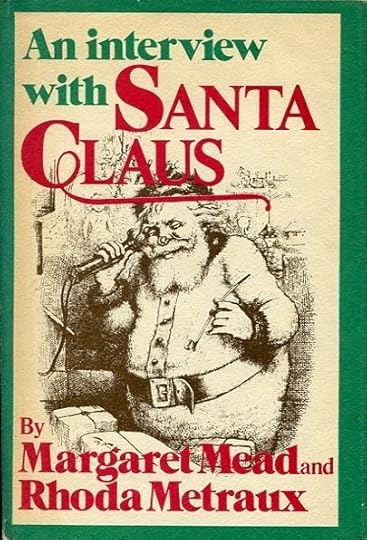 MARGARET MEAD HAD THE DISTINCTION, perhaps still has the distinction, of being the most famous anthropologist in the world. Close to the birth of modern anthropology, Mead's landmark book Coming of Age in Samoa (1928) helped introduce the idea of cultural relativism to the masses. For the rest of her life, even as her work was sometimes questioned, she remained a vocal and visible member of the intelligentsia on a wide range of subjects: sexual mores, parenting, folk traditions, and....even Santa Claus.
MARGARET MEAD HAD THE DISTINCTION, perhaps still has the distinction, of being the most famous anthropologist in the world. Close to the birth of modern anthropology, Mead's landmark book Coming of Age in Samoa (1928) helped introduce the idea of cultural relativism to the masses. For the rest of her life, even as her work was sometimes questioned, she remained a vocal and visible member of the intelligentsia on a wide range of subjects: sexual mores, parenting, folk traditions, and....even Santa Claus.IN DECEMBER 1942, with America's entry into World War II, Margaret Mead became the executive secretary of the National Research Council’s Committee on Food Habits. One of her research assistants was a woman thirteen years her junior named Rhoda Metraux. After the war, Metraux followed Mead to New York to became a graduate student at Columbia University, where Mead was a professor. From that time until Mead's death, the women collaborated on countless papers and books, and starting in 1955, Mead, divorced from her third husband, and Metraux, separated from her husband, moved in together as lifelong companions.
In 1977, the women decided they needed to answer some of the difficult questions Metraux's three-year-old granddaughter (Mead's goddaughter) had regarding Santa Claus. "Where does Santa come from?" "Where does he live?" "How can Santa be in so many places at one time?"
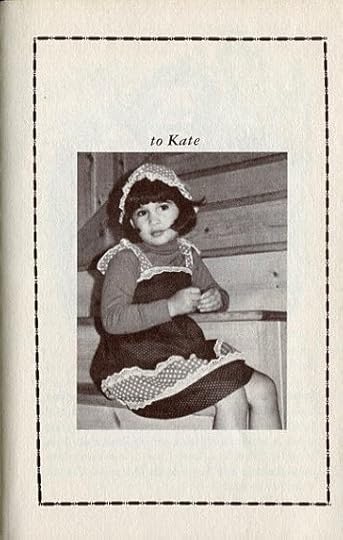 The obvious solution was to go to the source. They needed to interview Santa Claus. So they gave him a call.
The obvious solution was to go to the source. They needed to interview Santa Claus. So they gave him a call. MARGARET MEAD AND RHODA METRAUX: Is this The Santa Claus?
SANTA CLAUS: I suppose you might say so, yes.
M & R: Are you really alive?
SANTA: I certainly am--and very busy these days, too.The interview appeared in Redbook Magazine, where Mead and Metraux were contributing editors for over fifteen years. It turned out Santa was extremely knowledgeable about his familial history.
SANTA: I belong to a very big clan and a very old one--a clan of givers. As far as I know, our history goes back at least two thousand years, and maybe much longer, but when you get back that far, it's all hearsay and tales that are almost like fairy tales.Pressed to talk about his first ancestor, Santa explained who Saint Nicholas was.
(I'm sure that was one of three-year-old Kate's questions.)M & R: But how did he leave Asia Minor and come to Europe?
SANTA: Well, there are two different stories about that.There were actually many more stories than two. And they included how Santa got conflated with St. Nicholas, how some of the clan "had to pretend to be scary" like Knecht Ruprecht and Klaubach to punish naughty children, how some of the gift-givers were women like St. Lucia in Sweden and Austria and Babushka in Russia.
M & R: But, Santa Claus, let's come back to you.
SANTA: Oh, that's an exciting saga in itself. You know my immediate ancestors came to America with Dutch and German families. We were immigrants. And like all the other immigrants, we developed a whole new life style as we became Americans.It turned out, in the New World, the Santa clan used airplanes, helicopters, snowmobiles, and speedboats to get the toy deliveries done. But what about the reindeer? Oh, he still kept some reindeer, for the sake of tradition.
SANTA: Besides, there's a legend about a man--or maybe he was a god--who is said to have been one of our earliest ancestors. Thor, his name was, and people say that in the Far North, in midwinter, he used to come rushing down on the wind, bringing snow and ice and driving a team of reindeer. I wouldn't want to forget that, even if maybe it's only a legend.(See, Santa proved you could be both jolly and academic.)
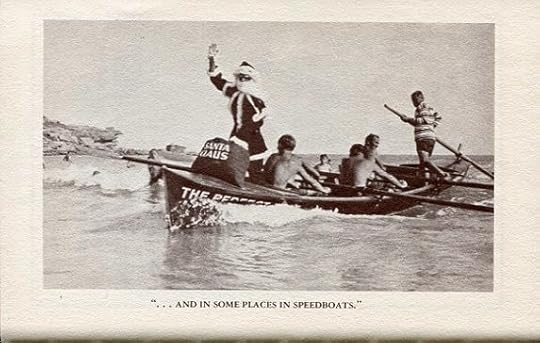 In case any children might have gotten confused about the conceit of this history lesson, Mead and Metraux revealed at the end that the phone call was all a dream, and that "gifts that seem to be given freely by wonderful, benign visitors are tokens of happy care given by mothers and fathers." WE HAVE NO WAY OF KNOWING how satisfied little Kate was with her grand- and godmothers' Christmas story. Sey Chassler, editor-in-chief at Redbook Magazine, wrote in the preface to the book edition of An Interview With Santa Claus (1978), "we believe [it] will become the new classic Christmas story." The New York Times wrote, "If aiming for something in the tradition of 'Yes, Virginia, There is a Santa Claus,' this one disappoints." Despite the question as to whether An Interview With Santa Claus is appropriate for the intended audience, Mead and Metraux should at least be applauded for adhering to their ideological beliefs. In Margaret Mead: Some Personal Views edited by Metraux and released the next year, Mead said:
In case any children might have gotten confused about the conceit of this history lesson, Mead and Metraux revealed at the end that the phone call was all a dream, and that "gifts that seem to be given freely by wonderful, benign visitors are tokens of happy care given by mothers and fathers." WE HAVE NO WAY OF KNOWING how satisfied little Kate was with her grand- and godmothers' Christmas story. Sey Chassler, editor-in-chief at Redbook Magazine, wrote in the preface to the book edition of An Interview With Santa Claus (1978), "we believe [it] will become the new classic Christmas story." The New York Times wrote, "If aiming for something in the tradition of 'Yes, Virginia, There is a Santa Claus,' this one disappoints." Despite the question as to whether An Interview With Santa Claus is appropriate for the intended audience, Mead and Metraux should at least be applauded for adhering to their ideological beliefs. In Margaret Mead: Some Personal Views edited by Metraux and released the next year, Mead said:Mead's hope was that:One thing my parents did — and I did for my own child — was to tell stories about the different kinds of Santa Claus figures known in different countries. The story I especially loved was the Russian legend of the little grandmother, the babushka, at whose home the Wise Men stopped on their journey. They invited her to come with them, but she had no gift fit for the Christ child and she stayed behind to prepare it. Later she set out after the Wise Men but she never caught up with them, and so even today she wanders around the world, and each Christmas she stops to leave gifts for sleeping children.
Children who have been told the truth about birth and death will know, when they hear about Kris Kringle and Santa Claus and Saint Nicholas and the little babushka, that this is a truth of a different kind.As they said at the end of the Interview:
Now it is enough for Kate, and all small children, to learn the legends of Santa Claus. Later, when legend and reality meet in a new way, she will begin to understand, we think, that giving is itself a kind of thank offering.FOR MORE INFORMATION on Mead's ideas about Santa Claus, see Maria Popova's article on Brain Pickings, which is where I found the quotes from Margaret Mead: Some Personal Views. For more literary Christmas fun, see my previous holiday posts: Pearl S. Buck's Christmas Stories here, here, and here.J.R.R. Tolkien's "Father Christmas Letters"
Eleanor Roosevelt's Christmas
Warren Chappell's The Nutcracker
Ilonka Karasz's The Twelve Days of Christmas All images are copyrighted © and owned by their respective holders.
Published on December 18, 2014 07:58
September 22, 2014
ISAK DINESEN ON HANS CHRISTIAN ANDERSEN
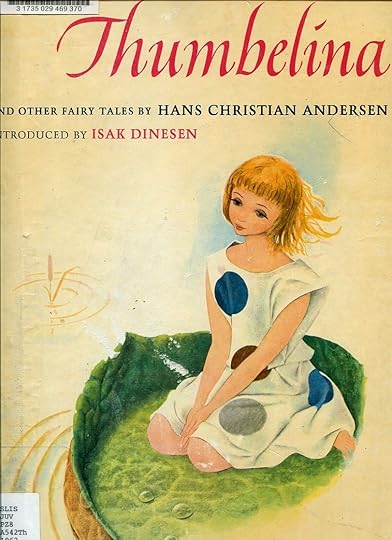 I HAVE SAVED THE BEST INTRODUCTION in Michael Di Capua's 1962 series of classic fairy stories for last. Isak Dinesen may now be best remembered for her memoir Out of Africa from the movie starring Robert Redford and Meryl Streep, but in her lifetime she was known for her Gothic stories. When asked to introduce a collection of her countryman Hans Christian Andersen's stories, rather than write a simple introduction, Dinesen supplied a ghost story, conjuring Andersen's spirit into her childhood room. "I had been told that the Dead were cold, but I have learned from him that there are people who have got such a rich, sweet glow in their hearts that they will always warm up those they touch." Taking Andersen's ghost by the hand, Dinessen follows him as he magics her room and her playthings like the numerous toys brought to life in his stories. Then, pulling him after her, she drags him through his own fictions, excitedly pointing everything out as though he had never seen them before, and he follows with an amused, knowing smile.
I HAVE SAVED THE BEST INTRODUCTION in Michael Di Capua's 1962 series of classic fairy stories for last. Isak Dinesen may now be best remembered for her memoir Out of Africa from the movie starring Robert Redford and Meryl Streep, but in her lifetime she was known for her Gothic stories. When asked to introduce a collection of her countryman Hans Christian Andersen's stories, rather than write a simple introduction, Dinesen supplied a ghost story, conjuring Andersen's spirit into her childhood room. "I had been told that the Dead were cold, but I have learned from him that there are people who have got such a rich, sweet glow in their hearts that they will always warm up those they touch." Taking Andersen's ghost by the hand, Dinessen follows him as he magics her room and her playthings like the numerous toys brought to life in his stories. Then, pulling him after her, she drags him through his own fictions, excitedly pointing everything out as though he had never seen them before, and he follows with an amused, knowing smile."You can make big things small," the young girl says, "and small things big and everything talk, and I am much braver since I have known you than I was before. Just wait till I grow up, and you will see that because I have known you, I am not even afraid of lions."
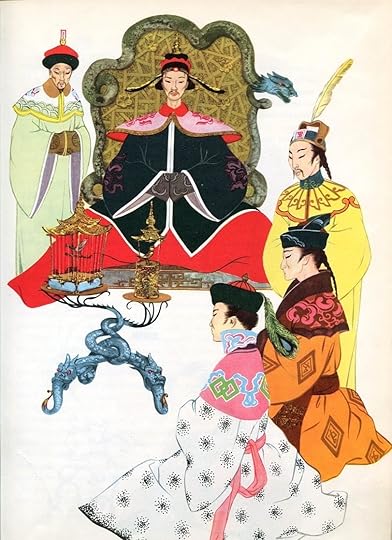 Eventually, Andersen is able to convince his passionate fan to return to bed, promising to "go and play with children in other countries," but he asks one last parting question, "which of my tales [do] you like best?"
Eventually, Andersen is able to convince his passionate fan to return to bed, promising to "go and play with children in other countries," but he asks one last parting question, "which of my tales [do] you like best?"The child Dinesen, or perhaps it is the adult writer Dinesen, says "I like them all! Let's ask the other children."
The stories included in this volume for consideration are "The Tinderbox," "The Nightingale," "The Shepherdess and the Chimney Sweep," "The Little Match Girl," and "Thumbelina." If a child never read any other Andersen collection, this is a near perfect selection of the essentials. As with the rest of the Macmillan series of fairy tales, the illustrations were provided by Sandro Nardini and Ugo Fontana.
At the end of her introduction, Dinesen's biography is given:
The greatest Danish writer since Hans Christian Andersen is certainly Isak Dinesen, who is really Baroness Karen Blixen Finecke. She is most admired for her "tales of blood and doom and honor in the old grand manner," tales that she writes in English rather than her native language. From 1914 until 1931 she lived in Africa, where she managed a coffee plantation for ten years before returning to Rungstedlund, her ancestral home in Denmark. She lives there today.To read the complete introduction--or short story, I would venture to call it--click on the images below.
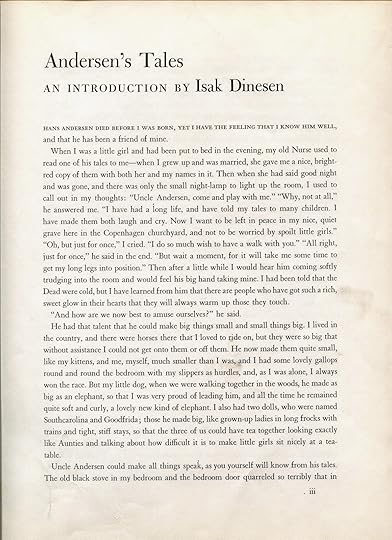
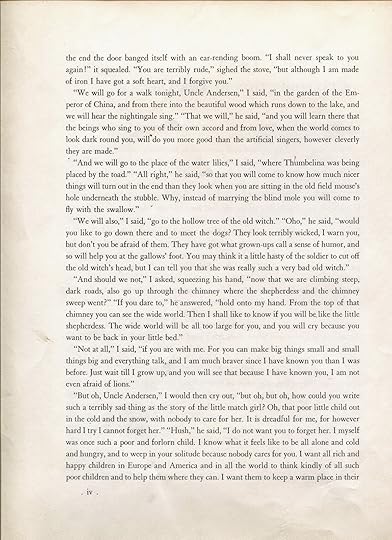
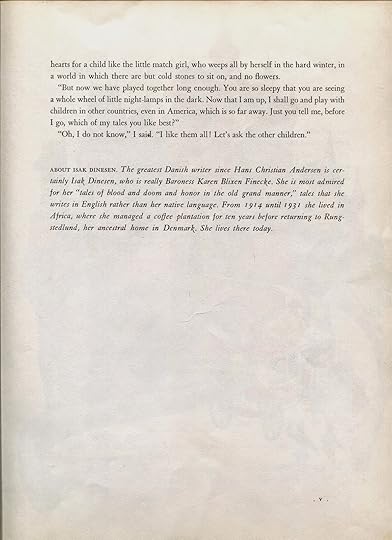
For the previous entries in this series, see:
Elizabeth Bowen on John Ruskin
Jean Stafford on the Arabian Nights
John Updike on Oscar Wilde
Randall Jarrell on the Brothers Grimm and Ludwig Bechstein
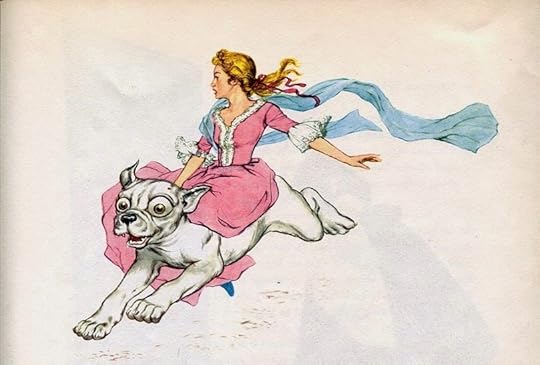
All images are copyrighted © and owned by their respective holders.
Published on September 22, 2014 08:19
September 8, 2014
WILD THINGS!
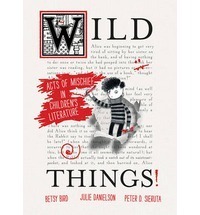 IF YOU FOLLOW MY BLOG, you are most likely interested in the esoterica of children's books: forgotten classics, eye-opening stories that make you reconsider cherished authors, behind-the-scenes history of children's literature. Three of the biggest bloggers in the children's book world have just released a book that is full of such tidbits,
Wild Things!
by Betsy Bird (
Fuse #8
), Julie Danielson (
Seven Impossible Things Before Breakfast
), and Peter D. Sieruta (
Collecting Children's Books
). It's like sitting around a table with three very amusing (and very amused) experts expounding on what they love, an informal book for causal reading. As my blog remains embarrassingly quiet, Wild Things! is a good alternative. I thank the good people at Candlewick Press for sending a copy my way.
IF YOU FOLLOW MY BLOG, you are most likely interested in the esoterica of children's books: forgotten classics, eye-opening stories that make you reconsider cherished authors, behind-the-scenes history of children's literature. Three of the biggest bloggers in the children's book world have just released a book that is full of such tidbits,
Wild Things!
by Betsy Bird (
Fuse #8
), Julie Danielson (
Seven Impossible Things Before Breakfast
), and Peter D. Sieruta (
Collecting Children's Books
). It's like sitting around a table with three very amusing (and very amused) experts expounding on what they love, an informal book for causal reading. As my blog remains embarrassingly quiet, Wild Things! is a good alternative. I thank the good people at Candlewick Press for sending a copy my way.
Published on September 08, 2014 18:36
July 15, 2014
ELIZABETH BOWEN ON RUSKIN'S KING OF THE GOLDEN RIVER
[image error]
JOHN RUSKIN IS BEST KNOWN as a highly influential 19th century art and architecture critic most famous for his three-volume treatise The Stones of Venice (1851-53). It seems natural then that his children's book, his only work of fiction, would appear on We Too Were Children. That's what WTWC is about after all, a towering writer not known for his children's work. However, The King of the Golden River was published in 1850, fifty years before WTWC's 20th century requirement, making it ineligible for inclusion. Which is why I'm happy to sneak Ruskin in the back door, as the fifth of the books I've covered in Macmillan's 1962 series of fairy tales with introductions by esteemed authors.
RUSKIN'S TALE IS INTRODUCED by Elizabeth Bowen. Bowen, who went on to win the John Tait Black Memorial Prize for her 1968 novel Eva Trout, or Changing Scenes, was already a literary grande dame when she contributed to the Macmillan series. Her bio reads:
Her introduction to Ruskin situates The King of the Golden River in the fairy tale tradition. "You may notice that while no good fairy stories are ever at all the same, many of them have something in common." In Ruskin's case, the fairy tale trope is three brothers, of whom the elder two are reprehensible and the youngest is fair and good.
There's no princess, Bowen admits, but there are fairies of a sort, "an odd-looking, fussy, bossy pair of old men." They are the South-West Wind, Esquire, who destroy the brothers' farm after the elder two show him no courtesy, and The King of the Golden River, who rewards the youngest brother for his generosity.
[image error] After addressing the story, Bowen draws attention to the story's setting. "The King of the Golden River (unlike many fairy stories) is not set in a quite imaginary land. This marvelous region of beauties, perils and mysteries is a real one, to be found on the map--Styria, a province of Austria." Bowen explains, "[Ruskin] gloried in natural scenery...He loved to breathe pure air (far from his dim-lit study) and sought it through travel and mountaineering." These life experiences find their way into the story.
Bowen does not go into any of the historical facts surrounding the composition of the story, which was written by Ruskin at age twenty-two for the twelve-year-old Effie Gray. Ruskin later married Gray, but never consummated the marriage, which was annulled six years later. Those details, while fascinating, wouldn't have been appropriate in a children's book, on the off chance any child were to actually ever read the introduction.
Regardless of how he came to write it, Ruskin clearly had fun in the composition. The story is five chapters long, much longer than a typical fairy tale. It does have a bit of moralizing, but Bowen is quick to say, "Don't, however, form the idea that John Ruskin 'preached' when he gave us The King of the Golden River. On the contrary: you are about to discover an exciting, semi-magic adventure story, with some eeriness but also some sturdy comedy."
Ruskin's story is easy to come by having been printed and illustrated many times, but as far as I know, Bowen's introduction has not been in print since the Macmillan edition. I've included the entire thing below. Click on the images to read.
[image error] [image error] [image error]
FOR PREVIOUS ENTRIES on the Macmillan series see:
Tales of the Brothers Grimm translated and introduced by Randall Jarrell
Tales of Ludwig Bechstein translated and introduced by Randall Jarrell
Tales of Oscar Wilde introduced by John Updike
Tales of the Arabian Nights retold and introduced by Jean Stafford
For more of Sandro Nardini's beautiful art from The King of the Golden River, see my Flickr set. If anyone knows anything about Nardini, please let me know. I've been unable to find anything about him.
All images are copyrighted © and owned by their respective holders.
[image error]
RUSKIN'S TALE IS INTRODUCED by Elizabeth Bowen. Bowen, who went on to win the John Tait Black Memorial Prize for her 1968 novel Eva Trout, or Changing Scenes, was already a literary grande dame when she contributed to the Macmillan series. Her bio reads:
[image error]Elizabeth Bowen has published five books of non-ficiton (including a memoir of her Dublin childhood), six collections of short stories and eight novels...In the Birthday Honours List of 1948, Elizabeth Bowen was created a Companion of the British Empire.Bowen's inclusion in the Order of the British Empire, the first order of chivalry to admit women, is testament to the regard with which her work was held.
Her introduction to Ruskin situates The King of the Golden River in the fairy tale tradition. "You may notice that while no good fairy stories are ever at all the same, many of them have something in common." In Ruskin's case, the fairy tale trope is three brothers, of whom the elder two are reprehensible and the youngest is fair and good.
There's no princess, Bowen admits, but there are fairies of a sort, "an odd-looking, fussy, bossy pair of old men." They are the South-West Wind, Esquire, who destroy the brothers' farm after the elder two show him no courtesy, and The King of the Golden River, who rewards the youngest brother for his generosity.
[image error] After addressing the story, Bowen draws attention to the story's setting. "The King of the Golden River (unlike many fairy stories) is not set in a quite imaginary land. This marvelous region of beauties, perils and mysteries is a real one, to be found on the map--Styria, a province of Austria." Bowen explains, "[Ruskin] gloried in natural scenery...He loved to breathe pure air (far from his dim-lit study) and sought it through travel and mountaineering." These life experiences find their way into the story.
Bowen does not go into any of the historical facts surrounding the composition of the story, which was written by Ruskin at age twenty-two for the twelve-year-old Effie Gray. Ruskin later married Gray, but never consummated the marriage, which was annulled six years later. Those details, while fascinating, wouldn't have been appropriate in a children's book, on the off chance any child were to actually ever read the introduction.
Regardless of how he came to write it, Ruskin clearly had fun in the composition. The story is five chapters long, much longer than a typical fairy tale. It does have a bit of moralizing, but Bowen is quick to say, "Don't, however, form the idea that John Ruskin 'preached' when he gave us The King of the Golden River. On the contrary: you are about to discover an exciting, semi-magic adventure story, with some eeriness but also some sturdy comedy."
Ruskin's story is easy to come by having been printed and illustrated many times, but as far as I know, Bowen's introduction has not been in print since the Macmillan edition. I've included the entire thing below. Click on the images to read.
[image error] [image error] [image error]
FOR PREVIOUS ENTRIES on the Macmillan series see:
Tales of the Brothers Grimm translated and introduced by Randall Jarrell
Tales of Ludwig Bechstein translated and introduced by Randall Jarrell
Tales of Oscar Wilde introduced by John Updike
Tales of the Arabian Nights retold and introduced by Jean Stafford
For more of Sandro Nardini's beautiful art from The King of the Golden River, see my Flickr set. If anyone knows anything about Nardini, please let me know. I've been unable to find anything about him.
All images are copyrighted © and owned by their respective holders.
[image error]
Published on July 15, 2014 11:50
July 7, 2014
JEAN STAFFORD: THE LION AND THE CARPENTER
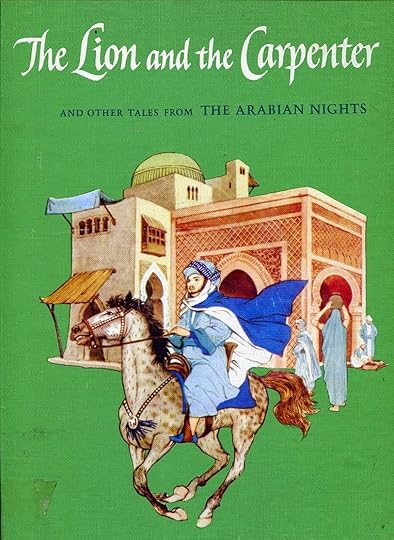 JEAN STAFFORD WAS THE ONLY CONTRIBUTOR other than Randall Jarrell to write the stories in her volume of fairy tales for Macmillan's 1962 series of oversized picture books, instead of just the introduction. In The Lion and the Carpenter and Other Tales from The Arabian Nights, Stafford's credit reads, "Retold and Introduced by Jean Stafford." Her included bio says:
JEAN STAFFORD WAS THE ONLY CONTRIBUTOR other than Randall Jarrell to write the stories in her volume of fairy tales for Macmillan's 1962 series of oversized picture books, instead of just the introduction. In The Lion and the Carpenter and Other Tales from The Arabian Nights, Stafford's credit reads, "Retold and Introduced by Jean Stafford." Her included bio says: "Miss Stafford...is the author of three distinguished and much admired novels (Boston Adventure, The Mountain Lion, and The Catherine Wheel), many short stories that have appeared in The New Yorker, Harper's Bazaar and elsewhere, and Eliphi, The Cat With The High I.Q., a book for children about her own cat of the same name."
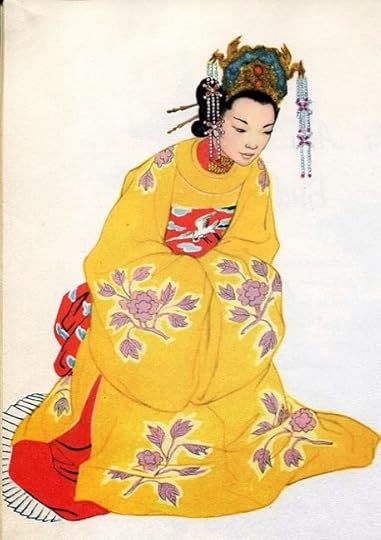 Stafford went on to win the Pultizer Prize for fiction in 1970 for her Collected Stories, but when she started working on her own versions of stories from the Arabian Nights for Michael di Capua's fairy tale series in 1962, she was seven years past her deadline for a new novel, and her most recent published novel was over a decade old. Writing the fairy tales was a way to avoid her more serious writing.
Stafford went on to win the Pultizer Prize for fiction in 1970 for her Collected Stories, but when she started working on her own versions of stories from the Arabian Nights for Michael di Capua's fairy tale series in 1962, she was seven years past her deadline for a new novel, and her most recent published novel was over a decade old. Writing the fairy tales was a way to avoid her more serious writing. Which didn't mean that she turned in inferior writing. In the plain language of fairy tales, Stafford retells the stories she selected with good humor and enough excitement for a reader to get lost in the telling. She explains in her introduction the Shahrazad frame narrative--the queen who must keep her husband in a constant state of anticipation by telling one story after another, or be killed in the morning--and that she chose "amazing happenings that are not quite so well known as the strange things that befell Sinbad in his wanderings, or Ali Baba's rapid rise from rags to riches, or the ups and downs of Aladdin's life when he became owner of his magic lamp." The stories are "Prince Kamar Al-Zaman and Princess Budur," "The Sandalwood Merchant and the Sharpers," "The Lion and the Carpenter," and "The Story of Abu-Kir and Abu-Sir."
Which didn't mean that she turned in inferior writing. In the plain language of fairy tales, Stafford retells the stories she selected with good humor and enough excitement for a reader to get lost in the telling. She explains in her introduction the Shahrazad frame narrative--the queen who must keep her husband in a constant state of anticipation by telling one story after another, or be killed in the morning--and that she chose "amazing happenings that are not quite so well known as the strange things that befell Sinbad in his wanderings, or Ali Baba's rapid rise from rags to riches, or the ups and downs of Aladdin's life when he became owner of his magic lamp." The stories are "Prince Kamar Al-Zaman and Princess Budur," "The Sandalwood Merchant and the Sharpers," "The Lion and the Carpenter," and "The Story of Abu-Kir and Abu-Sir."In "Prince Kamar Al-Zaman and Princess Budur," we learn of the most beautiful prince and the most beautiful princess in the world, who live many countries away from each other, unaware of the others' existence. A pair of genies, arguing over who is more beautiful, the prince or the princess, transports the sleeping princess to the sleeping prince's chamber so they can compare the two side-by-side. First, the prince, and then the princess wakes and sees the other one sleeping, and falls immediately in love. And once separated again by the genies, the two young lovers pine for each other for years, deathly sick with love until the princess's loyal brother manages to find her love and bring him to her.
 "The Sandalwood Merchant and the Sharpers" feels like a long joke. The sandalwood merchant goes to a distant city where he has been told that sandalwood is very valuable. Just before entering the city, a shepherdess warns him, "The people of this town are robbers and rogues, and their favorite sport is hoodwinking strangers." Despite the warning, the merchant is soon tricked out of his sandalwood for the promise of two handfuls of whatever he wishes, is accused of stealing a one-eyed man's eye, promises a cobbler whatever he desires for repairing his shoe, and ends up in debt to a gambler unless he drinks all of the water in the sea. Certain that he has caused his own doom, he meets the shepherdess again, who tells him that there is a wise man who all of the con artists consult at night to have that day's cons judged. The merchant finds this man, and hiding behind a rock, he hears the wise man explain to each of the con men how he could get out of their cons: He can request two handfuls of fleas, one of only males and one of only females, and when the man can't deliver, reclaim his sandalwood. He can demand that he and the one-eyed man each pluck out an eye to have them weighed in order to prove the one-eyed man's claim, and if they are equal in weight he will pay, but if not, the one-eyed man must pay him. Not wanting to be left blind, the man must drop the accusation. He can tell the cobbler that he has driven the sultan's enemies out of the country and that the sultan and his family are safe. If the cobbler says he is unsatisfied by this payment, he will be charged with treason. And he can tell the gambler that he will drink the sea, if the man brings it to him in a bottle. When the gambler is unable to, the merchant will be absolved of his debt. The sandalwood merchant enacts all of these solutions, sells his sandalwood at its proper value, and leaves the city rich.
"The Sandalwood Merchant and the Sharpers" feels like a long joke. The sandalwood merchant goes to a distant city where he has been told that sandalwood is very valuable. Just before entering the city, a shepherdess warns him, "The people of this town are robbers and rogues, and their favorite sport is hoodwinking strangers." Despite the warning, the merchant is soon tricked out of his sandalwood for the promise of two handfuls of whatever he wishes, is accused of stealing a one-eyed man's eye, promises a cobbler whatever he desires for repairing his shoe, and ends up in debt to a gambler unless he drinks all of the water in the sea. Certain that he has caused his own doom, he meets the shepherdess again, who tells him that there is a wise man who all of the con artists consult at night to have that day's cons judged. The merchant finds this man, and hiding behind a rock, he hears the wise man explain to each of the con men how he could get out of their cons: He can request two handfuls of fleas, one of only males and one of only females, and when the man can't deliver, reclaim his sandalwood. He can demand that he and the one-eyed man each pluck out an eye to have them weighed in order to prove the one-eyed man's claim, and if they are equal in weight he will pay, but if not, the one-eyed man must pay him. Not wanting to be left blind, the man must drop the accusation. He can tell the cobbler that he has driven the sultan's enemies out of the country and that the sultan and his family are safe. If the cobbler says he is unsatisfied by this payment, he will be charged with treason. And he can tell the gambler that he will drink the sea, if the man brings it to him in a bottle. When the gambler is unable to, the merchant will be absolved of his debt. The sandalwood merchant enacts all of these solutions, sells his sandalwood at its proper value, and leaves the city rich.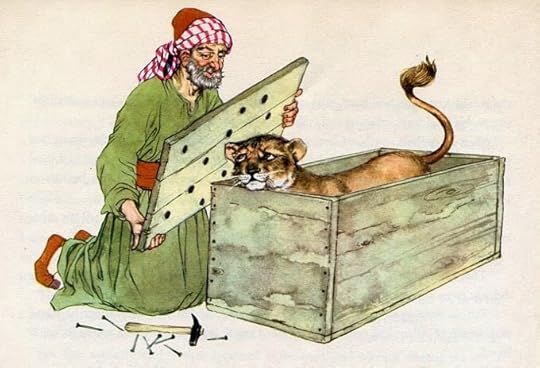 "The Lion and the Carpenter" is a story within a story. A duck, "quaking and quacking as if she had had the scare of her life," explains to a pair of peacocks that she is afraid of "the son of Adam." She tells them of meeting a horse, a camel, and a donkey who were all running away from the son of Adam, because of the horrible things he would do to them. A lion prince reassured the other animals, however, promising to protect them all. But when the man, a carpenter, came, he tricked the lion into a box so that even the lion was defeated. The peacocks reassure the duck that the son of Adam can't reach them on their island, and that she should stay with them in safety. But years later, a group of shipwrecked sailors appear and eat the duck. When the men leave, the peacocks agree that the duck died, because he didn't praise Allah enough.
"The Lion and the Carpenter" is a story within a story. A duck, "quaking and quacking as if she had had the scare of her life," explains to a pair of peacocks that she is afraid of "the son of Adam." She tells them of meeting a horse, a camel, and a donkey who were all running away from the son of Adam, because of the horrible things he would do to them. A lion prince reassured the other animals, however, promising to protect them all. But when the man, a carpenter, came, he tricked the lion into a box so that even the lion was defeated. The peacocks reassure the duck that the son of Adam can't reach them on their island, and that she should stay with them in safety. But years later, a group of shipwrecked sailors appear and eat the duck. When the men leave, the peacocks agree that the duck died, because he didn't praise Allah enough. In "The Story of Abu-Kir and Abu-Sir," we are introduced to the nefarious dyer Abu-Kir and his friend, the noble barber Abu-Sir. For the first half of the story, Abu-Kir takes malicious advantage of Abu-Sir. Then, when Abu-Kir is in a position of wealth and power, instead of helping Abu-Sir, the way the barber had before, he has him beaten and thrown in the street. When Abu-Sir rises to a position of wealth and power himself, Abu-Kir accuses him of a plot to kill the sultan, and the sultan orders the good Abu-Sir's death. However, the truth is revealed, and Abu-Kir is rightfully killed instead.
In "The Story of Abu-Kir and Abu-Sir," we are introduced to the nefarious dyer Abu-Kir and his friend, the noble barber Abu-Sir. For the first half of the story, Abu-Kir takes malicious advantage of Abu-Sir. Then, when Abu-Kir is in a position of wealth and power, instead of helping Abu-Sir, the way the barber had before, he has him beaten and thrown in the street. When Abu-Sir rises to a position of wealth and power himself, Abu-Kir accuses him of a plot to kill the sultan, and the sultan orders the good Abu-Sir's death. However, the truth is revealed, and Abu-Kir is rightfully killed instead.JEAN STAFFORD's other children's book, Eliphi, The Cat With the High IQ, mentioned above, came out in the same year as The Lion and the Carpenter. Stafford never published for children again
I will get to Eliphi in a future post, and there are two more volumes in the Macmillan series that I hope to touch upon.
All images are copyrighted © and owned by their respective holders.
Published on July 07, 2014 14:12
June 23, 2014
JOHN UPDIKE ON OSCAR WILDE'S FAIRY STORIES
 MANY YEARS AGO, in the early days of We Too Were Children, I invoked Rachel Cohen's superb book A Chance Meeting, which describes the ways in which literary lives are intertwined as one writer meets another, in some cases only once, in others in lasting friendships over many years, and that author meets another and so on, drawing a haphazard line through the history of literature. On We Too Were Children, the authors and illustrators might never have met in person, but one book leads to another, which leads to another, which often leads back to another book I have already covered. For example, Nancy Ekholm Burkert, who I most recently wrote about in relation to Randall Jarrell, I first wrote about over three years ago in relation to John Updike. Jarrell contributed translations of two volumes of fairy tales--Grimm and Bechstein--to a series spearheaded by Michael di Capua at Macmillan in 1962, something I discovered when I set out to write about Jarrell's other children's books. And it wasn't until one of those books was in my hands that I even discovered on the back of the book that it was part of a series, and that one of the other illustrious writers who had contributed to the series, in this case an introduction, was an author I had already covered, John Updike. A "chance meeting" indeed.
MANY YEARS AGO, in the early days of We Too Were Children, I invoked Rachel Cohen's superb book A Chance Meeting, which describes the ways in which literary lives are intertwined as one writer meets another, in some cases only once, in others in lasting friendships over many years, and that author meets another and so on, drawing a haphazard line through the history of literature. On We Too Were Children, the authors and illustrators might never have met in person, but one book leads to another, which leads to another, which often leads back to another book I have already covered. For example, Nancy Ekholm Burkert, who I most recently wrote about in relation to Randall Jarrell, I first wrote about over three years ago in relation to John Updike. Jarrell contributed translations of two volumes of fairy tales--Grimm and Bechstein--to a series spearheaded by Michael di Capua at Macmillan in 1962, something I discovered when I set out to write about Jarrell's other children's books. And it wasn't until one of those books was in my hands that I even discovered on the back of the book that it was part of a series, and that one of the other illustrious writers who had contributed to the series, in this case an introduction, was an author I had already covered, John Updike. A "chance meeting" indeed.John Updike's introduction, entitled "Forward For Young Readers," graces a volume of three fairy tales by Oscar Wilde. Wilde published two collections of fairy tales in his varied career, many of the stories first appearing in magazines: The Happy Prince and Other Stories (1888) and House of Pomegranates (1891). As Updike reminds us, "Oscar Wilde wrote in a time when grown men wrote very seriously for young readers." Updike, who in 1962 was about to publish his first children's book, wrote his "Forward For Young Readers" just as seriously. He opens with a discussion of the etymology of the word "Fairy," which he uses to segue into the way in which Christianity drowned out pagan beliefs in Europe, leaving only fairy stories, "the substance [of which] is pagan wood, but the taste and glisten is of Christain salt."

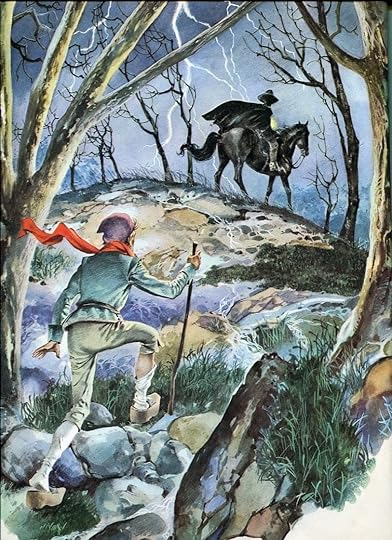
In the modern age, fairy stories become necessary, Updike says, "For if men do not keep on speaking terms with children, they cease to be men, and become merely machines for eating and for earning money. This danger was not so clear until machines entered the world in force and began to make men resemble them."
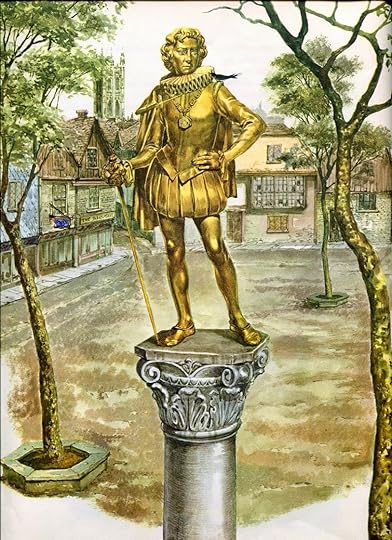
Updike does manage to introduce the actual stories contained in the volume, "The Young King," "The Devoted Friend," and Wilde's most famous children's story, "The Happy Prince," teasing each one with a cryptic image central to each respective story. Then he warns us that the stories, unlike "so many modern books for children," do not "skip the subject of suffering. On the contrary: suffering is exactly what they are about....But," he goes on, "if you dare read them, you will enter a rich and precious world."
As with all of his writing, Updike brings to his introduction deep intelligence, visceral language, and humor. In some ways, his essay is more enjoyable to read than Wilde's overwrought stories. It is amazing to read in his attached bio that he was only thirty years old when he wrote it. "As the father of Elizabeth, David, Michael, and Miranda," he adds, "he has a special interest in fairy tales and storytelling." His own children's books followed in the subsequent few years.
Updike included "Foreword for Young Readers" in his first collection of nonfiction, Assorted Prose, but as near as I can tell, the essay is currently out of print. I have scanned the entire thing, and posted it below. If you click into each image, it should be easy to read. It's short, and worth it.
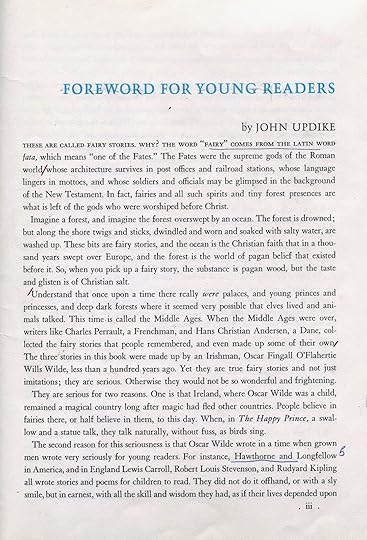


In addition to Updike and Jarrell, the Macmillan series of "marvelous tales" included introductions by Jean Stafford, Elizabeth Bowen, and Isak Dinesen, which I plan to write about in upcoming posts.
All images are copyrighted © and owned by their respective holders
Published on June 23, 2014 19:18
June 18, 2014
RANDALL JARRELL: THE GINGERBREAD RABBIT
 AFTER RECEIVING RANDALL JARRELL'S TRANSLATIONS for The Brothers Grimm, his editor Michael di Capua suggested that Jarrell try his hand at an original children's story. Intrigued, Jarrell took a notebook to the hammock in his backyard, and with a radio blaring, he composed his own fairy tale, The Gingerbread Rabbit.
AFTER RECEIVING RANDALL JARRELL'S TRANSLATIONS for The Brothers Grimm, his editor Michael di Capua suggested that Jarrell try his hand at an original children's story. Intrigued, Jarrell took a notebook to the hammock in his backyard, and with a radio blaring, he composed his own fairy tale, The Gingerbread Rabbit.The Gingerbread Rabbit is a variation on the story "The Gingerbread Boy." In Jarrell's version, a young mother makes her daughter a gingerbread rabbit while her daughter is at school. When the mother steps out for a moment, the kitchen implements inform the Gingerbread Rabbit that he is going to be eaten. Frightened by the giant with "dozens of tremendous shining white teeth the size of a grizzly bear's," the Gingerbread Rabbit races out the door with the young mother in pursuit.
In the woods, the Gingerbread Rabbit meets a fox, who tells the rabbit that he is also a rabbit, and invites him into his den with the intention of eating the Gingerbread Rabbit. A real rabbit comes along just in time, and drags the Gingerbread Rabbit away. He brings the Gingerbread Rabbit to his burrow, where he and his wife, who have "always wanted to have a little rabbit of [their] own" adopt the confectionery bunny. The human mother gives up her chase, and decides she will go home and sew her daughter a cloth bunny instead.
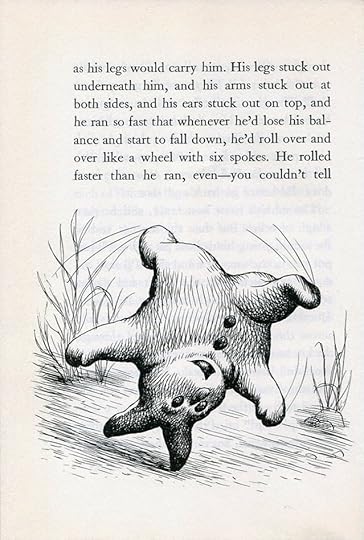 AS FANTASTICAL AS THE STORY SOUNDS, and as openly as it wears its folkloric origins, The Gingerbread Rabbit is built from Jarrell's own childhood, from material he had already mined in his poetry. At the age of eleven, Jarrell's parents separated. His mother returned to Nashville, Tennessee with his brother, while Jarrell remained with his grandparents at their farm in Hollywood. There, his grandparents gave him a pet bunny named Reddy. One traumatic day, the young Jarrell witnessed his grandmother slaughter a chicken. As he describes in his poem "The Lost World:"
AS FANTASTICAL AS THE STORY SOUNDS, and as openly as it wears its folkloric origins, The Gingerbread Rabbit is built from Jarrell's own childhood, from material he had already mined in his poetry. At the age of eleven, Jarrell's parents separated. His mother returned to Nashville, Tennessee with his brother, while Jarrell remained with his grandparents at their farm in Hollywood. There, his grandparents gave him a pet bunny named Reddy. One traumatic day, the young Jarrell witnessed his grandmother slaughter a chicken. As he describes in his poem "The Lost World:"[Grand]Mama comes out and takes in the clothesJarrell asked his grandmother if she could ever do such a thing to his pet rabbit, and his grandmother reassured him that she never would. Then, after a year on his own at his grandparents, it was decided that he should rejoin his mother and brother. Jarrell didn't want to go, and begged his grandparents to let him stay with them. His appeal was denied, and once he had gone back east, Reddy was slaughtered and eaten for dinner.
From the clothesline. She looks with righteous love
At all of us, her spare face half a girl's.
She enters a chicken coop, and the hens shove
And flap and squawk, in fear; the whole flock whirls
Into the farthest corner. She chooses one,
Comes out, and wrings its neck. The body hurls
Itself out--lunging, reeling, it begins to run
Away from Something, to fly away from Something
In great flopping circles. Mama stands like a nun
In the center of the awful, anguished ring.
The thudding and scrambling go on, go on--then they fade,
I open my eyes, it's over...Could such a thing
Happen to anything? It could happen to a rabbit, I'm afraid...
The Gingerbread Rabbit's fear of being eaten is Jarrell's childhood fear for his pet. And his wish to be adopted by a kind older couple, the real rabbits at the end of the book, is Jarrell's desire to stay with his grandparents. But in the picture book, these fears and wishes could be answered in a way they weren't in reality, with a happy ending.
 WHEN JARRELL FINISHED the writing for The Gingerbread Rabbit, he turned his attention to the illustrations. His wife Mary wrote, "Jarrell rather assumed that the writer found some illustrations he liked, told the editor about it, and the illustrator would come running." After seeing The Rescuers by Margery Sharp, Jarrell settled on the illustrator Garth Williams without realizing that the illustrator of Charlotte's Web and Little House on the Prairie might not be an easy illustrator to hire. In the end, di Capua was able to convince the esteemed artist to take on The Gingerbread Rabbit.
WHEN JARRELL FINISHED the writing for The Gingerbread Rabbit, he turned his attention to the illustrations. His wife Mary wrote, "Jarrell rather assumed that the writer found some illustrations he liked, told the editor about it, and the illustrator would come running." After seeing The Rescuers by Margery Sharp, Jarrell settled on the illustrator Garth Williams without realizing that the illustrator of Charlotte's Web and Little House on the Prairie might not be an easy illustrator to hire. In the end, di Capua was able to convince the esteemed artist to take on The Gingerbread Rabbit.With Williams in Mexico and Jarrell in North Carolina, all communiques were made through di Capua. In July of 1962, Jarrell sent the following guidelines,
"The rabbit himself ought to be very sincere and naive and ingenuous, so that his whole body and face express what he feels. The big rabbit ought to be handsome, secure and competent-looking; the mother rabbit should be delicate and demure and beautiful. The fox should be very smooth and flashy, like Valnetino playing W. C. Fields. The little girl's mother should be young (28 or so) and beautiful and kind, just the mother a little girl would want; the little girl should be something any little girl can immediately identify with."Over the next few months, Jarrell finished writing his second children's book The Bat Poet, begun in the same hammock that had yielded The Gingerbread Rabbit. di Capua wanted Maurice Sendak to do the illustrations, and provided Jarrell with examples of Sendak's work. With Sendak's art as a point of comparison, Jarrel began to doubt his original choice of illustrator. In December of 1962, a disheartened Jarrell wrote to di Capua, "If you could tell Williams how much I liked the pen-and-ink style of The Rescuers, and that I would be enchanted to have The Gingerbread Rabbit somewhat like that, perhaps he'd feel like it."
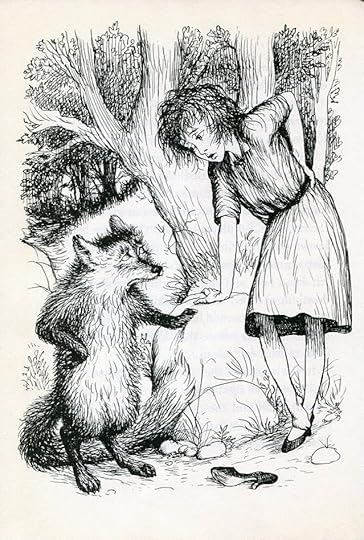 Whatever reservations Jarrell harbored that winter, when nearly finished illustrations for The Gingerbread Rabbit reached him in March of 1963, he wrote:
Whatever reservations Jarrell harbored that winter, when nearly finished illustrations for The Gingerbread Rabbit reached him in March of 1963, he wrote:"I'm delighted with the drawings: the gingerbread rabbit's very cute and touching. The fox is wonderful, and the old rabbit in the colored sketch makes me want to be adopted by him...I believe Williams is getting quite inspired and will make a charming book."The New York Times agreed. Of the finished product they said, "Garth Williams has drawn his landscape and personae in the best possible way, without "side" or innuendo, en punto." They said of Jarrell, "As always, [Jarrell's] prose here is straightforward, the tone is right, the learning informs subtly, the sensibility is in control. In short, the tale is in perfect taste."
The book, while now considered the weakest of Jarrell's works for children, resonated with readers as well. It remains in print today, a great accomplishment for a first-time children's book author. Without it, there might not have been the three books to come.
QUOTES FROM JARRELL'S LETTERS come from The Children's Books of Randall Jarrell by Jerome Griswold with an introduction by Mary Jarrell, and from Randall Jarrell's Letters, edited by Mary Jarrell. Additional background information came from Randal Jarrell: A Literary Life by William H. Pritchard.
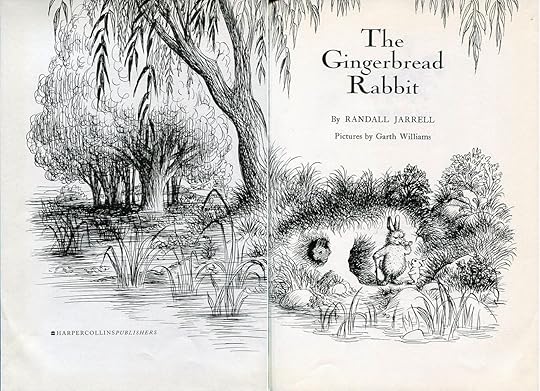
All images are copyrighted © and owned by their respective holders.
Published on June 18, 2014 11:35
June 4, 2014
RANDALL JARRELL: THE RABBIT CATCHER AND OTHER FAIRY TALES OF LUDWIG BECHSTEIN
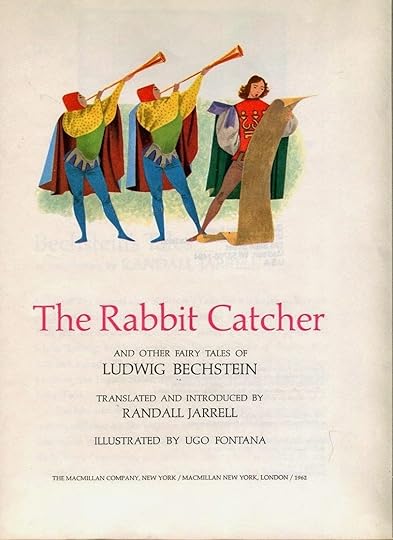 "EVERYBODY has read some of Grimm's Tales," writes Randall Jarrell in his introduction to The Rabbit Catcher and Other Fairy Tales of Ludwig Bechstein, "but it is surprising how few people have read German fairy tales translated from other books." Jarrell sets out to remedy that with his second contribution to Macmillan's series of marvelous tales, three stories by Ludwig Bechstein.
"EVERYBODY has read some of Grimm's Tales," writes Randall Jarrell in his introduction to The Rabbit Catcher and Other Fairy Tales of Ludwig Bechstein, "but it is surprising how few people have read German fairy tales translated from other books." Jarrell sets out to remedy that with his second contribution to Macmillan's series of marvelous tales, three stories by Ludwig Bechstein.Bechstein was a contemporary and ardent admirer of the Grimms. When they refused to allow him to produce an abridgment of their work, he chose to write his own book of fairy tales, which was published in 1845. Jarrell: "In his introduction to his book Bechstein calls the fairy tale 'the restless and homeless, floating bird-of-pardise of innocent tradition.'" Bechstein managed to catch that 'bird-of-paradise.' His volume outsold the Grimms' in Germany until the 1890s.
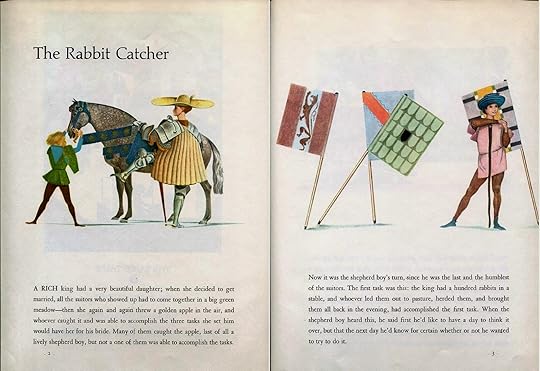 From the introduction through the translations, Jarrell's Bechstein is far more relaxed than his Grimm. Where the Grimm introduction quoted at length from a German poet and mentioned the H-bomb, the Bechstein introduction includes revealing intimacies: "I never heard anyone called a heavenly man before, but it's already become a family phrase in my family." Throughout the whole book, the reader can sense how much fun Jarrell is having.
From the introduction through the translations, Jarrell's Bechstein is far more relaxed than his Grimm. Where the Grimm introduction quoted at length from a German poet and mentioned the H-bomb, the Bechstein introduction includes revealing intimacies: "I never heard anyone called a heavenly man before, but it's already become a family phrase in my family." Throughout the whole book, the reader can sense how much fun Jarrell is having.The tales are "The Rabbit Catcher," "The Brave Flute-Player," and "The Man and the Wife in the Vinegar Jug." Jarrell says, "The stories, even down to their last bit of style, are as plain and homely as can be." But he means this as a compliment. His love for the stories is apparent. Except he takes especial care to make clear that the "Fisherman and His Wife" variant "The Man and the Wife in the Vinegar Jug," holds nothing to the original.
 "THE RABBIT CATCHER" is of the variety of tales where a young suitor is set a series of impossible tasks in order to earn the right to wed the princess. When given the first task--to lead one hundred rabbits out to the fields, let them graze for the day, and bring every single one back--he asks for a day to think it over. As he is fretting over this challenge, a little, old lady gives him a whistle and tells him, "'Take good care of it, it will do a lot for you!'" With the whistle in hand, he agrees to the challenge.
"THE RABBIT CATCHER" is of the variety of tales where a young suitor is set a series of impossible tasks in order to earn the right to wed the princess. When given the first task--to lead one hundred rabbits out to the fields, let them graze for the day, and bring every single one back--he asks for a day to think it over. As he is fretting over this challenge, a little, old lady gives him a whistle and tells him, "'Take good care of it, it will do a lot for you!'" With the whistle in hand, he agrees to the challenge.But the king and princess are concerned that the boy might succeed. Each comes to him in the field in disguise asking to buy a rabbit, so that he will not have all one hundred when he returns. First he convinces the princess to kiss him in exchange for a rabbit, and then the king to kiss his donkey. But as each leaves, he uses the magic whistle to recall the bunnies, and at the end of the day he brings all one hundred in.
 The whistle helps with the next task--to separate one hundred bushels of peas and a hundred bushels of lentils in the dark--by bringing a swarm of ants who complete the challenge, and the last--to eat a roomful's worth of bread in a night--by bringing "so many mice..that it was almost sinister."
The whistle helps with the next task--to separate one hundred bushels of peas and a hundred bushels of lentils in the dark--by bringing a swarm of ants who complete the challenge, and the last--to eat a roomful's worth of bread in a night--by bringing "so many mice..that it was almost sinister."Having completed the challenges, the king tries one last trick to try to cheat the boy out of the princess's hand: he must fill a bag of lies. But when the boy starts to say that he had made the king kiss a donkey, the king cuts him off, says the bag is full, and relinquishes his daughter.
"THE BRAVE FLUTE-PLAYER" tells of a musician who stops for the night at a farm, where he learns that the nearby abandoned castle is home to a treasure that no one can claim, because it is haunted and everyone who has gone in at night has never returned. Unafraid, the musician goes into the castle, and the farmer, left at home, can gauge how the musician is faring, because the sound of his flute drifts down to the farm.
 At eleven o'clock, two men carry in a coffin and leave. The musician opens the coffin--the farmer is sure he is dead, because the music has stopped--takes out the little shriveled corpse, sets it by the fire, and soon it comes to life. The wrinkled, little man leads the musician to a room full of gold, and tells him if he can evenly divide the gold in two, half would belong to him and half would go to the poor. The musician divides the piles of coins, but there is one left over. He cuts it in half, making him the first to succeed in one hundred years, and the old man grants him the money. The musician begins to play, and the farmer is overjoyed at the sound.
At eleven o'clock, two men carry in a coffin and leave. The musician opens the coffin--the farmer is sure he is dead, because the music has stopped--takes out the little shriveled corpse, sets it by the fire, and soon it comes to life. The wrinkled, little man leads the musician to a room full of gold, and tells him if he can evenly divide the gold in two, half would belong to him and half would go to the poor. The musician divides the piles of coins, but there is one left over. He cuts it in half, making him the first to succeed in one hundred years, and the old man grants him the money. The musician begins to play, and the farmer is overjoyed at the sound."THE MAN AND THE WIFE IN THE VINEGAR JUG," as Jarrell said in his introduction, is a variant of "The Fisherman and His Wife." In this, it is a golden bird who grants each of the couple's escalating wishes, and for no apparent reason. And unlike the fisherman who is driven to each new wish by his greedy wife, here both members of the couple seem equally eager to first live in a cottage, then in the city, then as nobles, as king and queen, and at last as God. With that request, "Bang, all their magnificence went down to the devil, and both of them, the man and his wife, were back in the vinegar jug again."
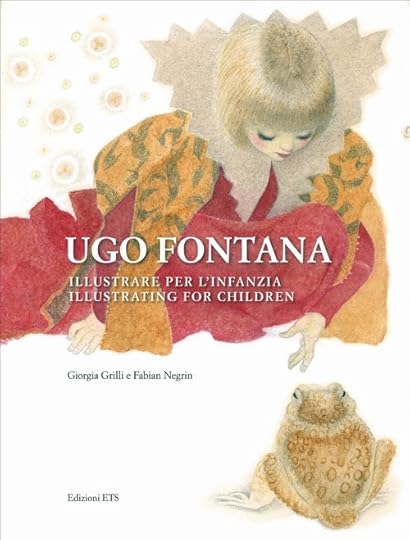 THE RABBIT CATCHER'S BEAUTIFUL ILLUSTRATIONS were done by Ugo Fontana, a legend of children's book illustration in his native Italy. Fontana was selected this year as the first illustrator to be spotlighted in the annual exhibition 'The Lost Treasure' at the Bologna International Children's Book Fair. A 200-page bilingual book was released in conjunction with the festival. If anyone has this book and is trusting enough to lend it to me, I will happily devote a blog post to this amazing illustrator. To see all of his illustrations for The Rabbit Catcher, view my Flickr set here.
THE RABBIT CATCHER'S BEAUTIFUL ILLUSTRATIONS were done by Ugo Fontana, a legend of children's book illustration in his native Italy. Fontana was selected this year as the first illustrator to be spotlighted in the annual exhibition 'The Lost Treasure' at the Bologna International Children's Book Fair. A 200-page bilingual book was released in conjunction with the festival. If anyone has this book and is trusting enough to lend it to me, I will happily devote a blog post to this amazing illustrator. To see all of his illustrations for The Rabbit Catcher, view my Flickr set here.For information on Ludwig Bechstein, I consulted The Teller's Tale: Lives of the Classic Fairy Tale Writers edited by Sophie Raynard.
NEXT: Jarrell's Original Children's Books
All images are copyrighted © and owned by their respective holders.
Published on June 04, 2014 18:55
June 3, 2014
RANDALL JARRELL'S GRIMM: THE ILLUSTRATORS
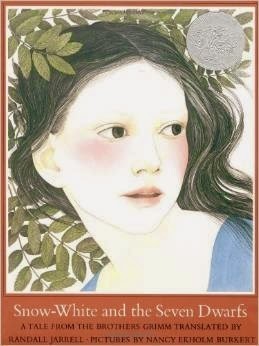
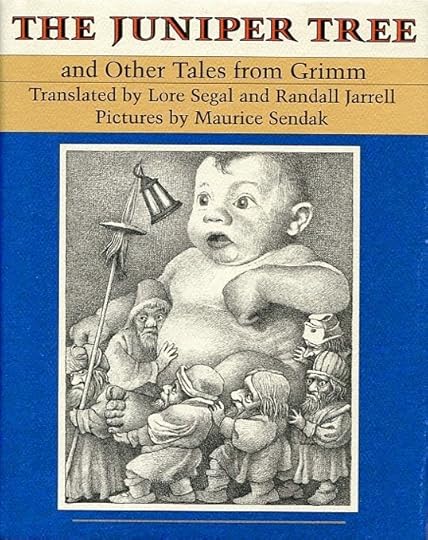
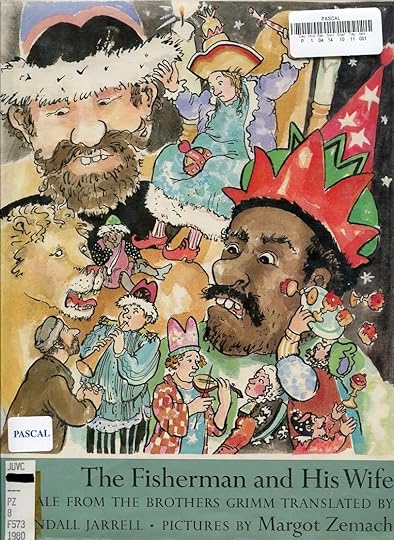
WHEN NANCY EKHOLM BURKERT'S picture book Snow-White and the Seven Dwarfs was published in 1972, John Gardner writing in The New York Times said, "People who care about book illustrations have known for some time that one of the best illustrators to be found is Nancy Ekholm Burkert...[and] her new book...transcends her previous accomplishments." He then goes on to say, "Looking at [the illustrations], you wish they were the first pictures you'd seen in your life...Though...I would not wish that the first fairy tale I ever heard was a version by Jarrell. I find his version anything but faithful."
Gardner's harsh criticism, however, must be a minority opinion if the caliber of illustrators who have chosen Jarrell's text is any indication. In addition to Burkert, the legendary Maurice Sendak and the Caldecott-winning illustrator Margot Zemach have also taken turns illustrating the stories that originally appeared in Jarrell's The Golden Bird and Other Fairy Tales . The Brothers Grimms' tales are a children's book illustrator's delight, a chance to showcase her art the way that an actor puts his stamp on Shakespeare. And artists of Burkert, Sendak, and Zemach's stature can take their pick of translations, or even warrant new translations. But all three chose Jarrell, and through his translations created some of their best work.
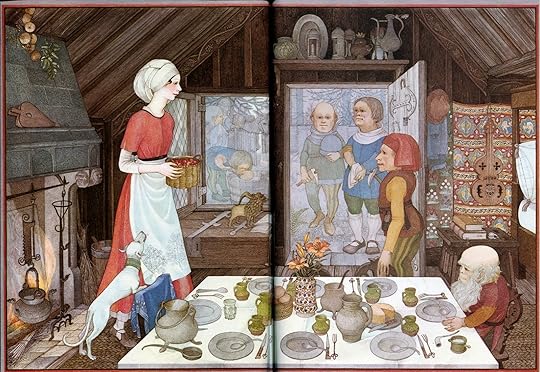
LONG TIME READERS OF WTWC,MB, will remember how highly I revere Nancy Ekholm Burkert. Snow-White has become her legacy, appallingly the only one of her books (save her most recent) that remains in print. This is because the American Library Association awarded Burkert the prestigious Caldecott Honor for it, recognizing it as one "of the most distinguished American picture books for children."
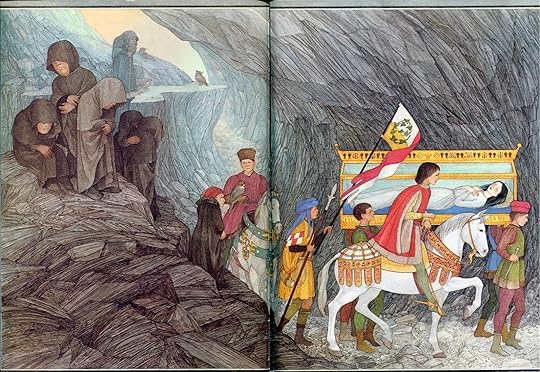
The book in its first edition was 12.25" x 9.25" making it a little too big for my scanner. So my scans, as it seems are most of the scans available online, are slightly cropped. The good news is that you can easily see the illustrations as they are meant to be seen by buying the book now.
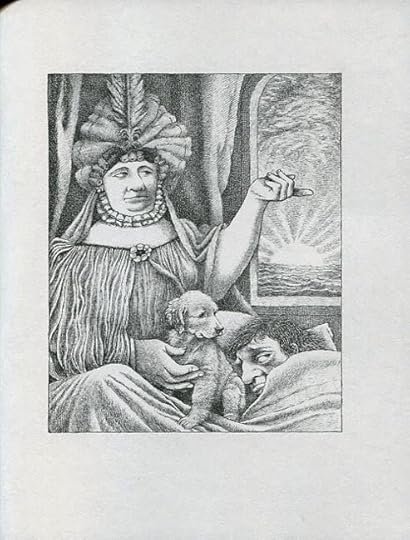
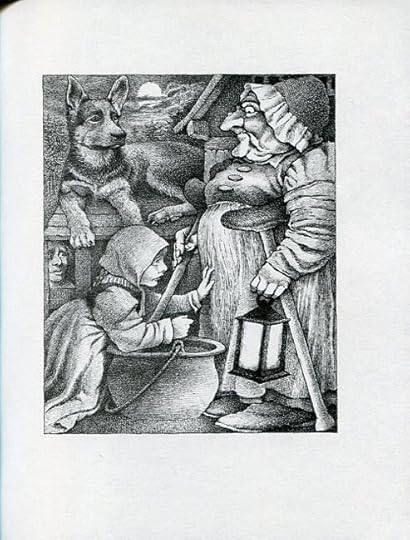
MAURICE SENDAK, who needs no introduction, was Jarrell's primary illustrator, illustrating three of Jarrell's four original children's books. In 1962, when Jarrell turned in his Grimm translations, editor Michael di Capua was so happy with them that he thought about commissioning a larger translation from the poet. di Capua approached Maurice Sendak about illustrating the expanded Grimm, but before the project progressed any further, Jarrell turned in his original story The Bat-Poet. di Capua convinced Sendak to illustrate the new book, and plans for a new Grimm were put on hold. When Jarrell died in 1965, the Grimm book had never begun.
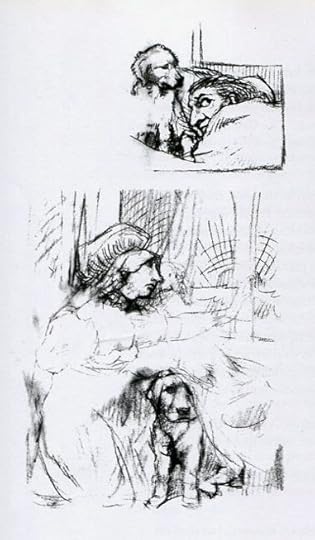
Several years later, Sendak and the Austrian-born author Lore Segal started work on their own Grimm. Growing out of the earlier project, four of Jarrell's five translations were included: "The Fisherman and His Wife," "Hansel and Gretel," "The Golden Bird," and "Snow-White and the Seven Dwarfs."
In his preparatory notes for the illustrations for "The Fisherman and His Wife," (the woman pointing at the rising sun above; right: preliminary sketches) Sendak wrote, "No fish! No hut! No palace! Her à la Grafina Potatska! Yes!" Grafina Potatska, an idiotic Polish count, was what Sendak's mother called his father when she was angry with him. The woman's expression is his mother's. The puppy on the bed is Sendak's golden retriever Io.
Sendak found that the more familiar tales were harder to illustrate. The single illustration for "Snow White" took over six months with several iterations. The illustration for "Hansel and Gretel" took two weeks. His goal with each illustration was "catching that moment when the tension between story line and emotions is at its greatest." For "Snow White," he focused on the conflict between the older generation and the young generation. For "Hansel and Gretel" he tried to capture the moment "the very second before she performs her fearless deed."
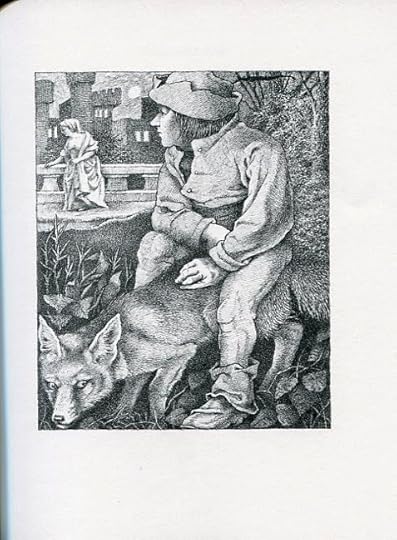

There are twenty-three other stories in Sendak's Grimm, entitled The Juniper Tree and Other Tales from Grimm and still in print. Sendak said of the book, "It was a watershed book for me, one that solved a great many technical and emotional problems...a hard job, which took many years of preparation and concentrated effort."
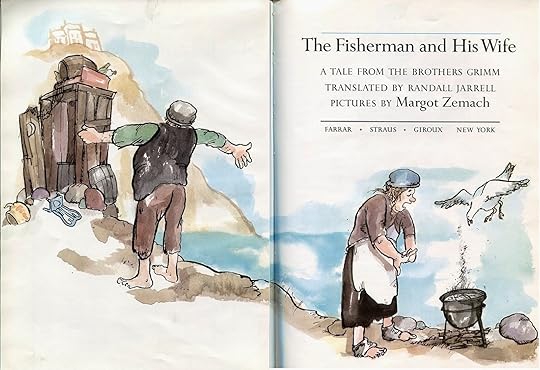
ON MARGOT ZEMACH'S DEATH, Maurice Sendak said, "Margot not only revivified the American picture book, but was one of the very few who helped elevate it to an art form." Awarded the Caldecott Medal in 1974 for her book Duffy and the Devil, she also received two Caldecott Honors in the 1970s. In 1980, Zemach published her rendition of Jarrell's telling of The Fisherman and His Wife. On its appearance, Kirkus Review said, "'If The Fisherman and His Wife' must be illustrated, let it be by Margot Zemach--who has the comic-cataclysmic range, the vigor, the intelligence for the task."
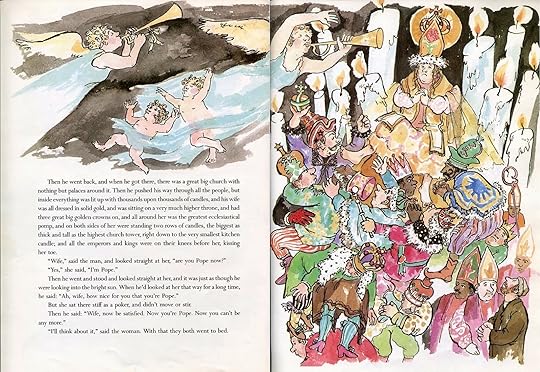

Kirkus comments on Jarrell's translation as well, quoting his "well-chosen words....His is a less patterned telling than, say Wanda Gag's--richer in language, fuller in incident."
All of Zemach's illustrations for the book are brilliant, overflowing with energy and details that make the story her own. Unfortunately out of print, I have posted many more illustrations on my Flickr set here.
IN UPCOMING POSTS, I will further explore Sendak and Jarrell's collaborations as well as work by some of the other artists who have worked on Jarrell's children's books. For background information on Maurice Sendak's work in this post, I consulted The Art of Maurice Sendak by Selma G. Lanes.
All images are copyrighted © and owned by their respective holders.
Published on June 03, 2014 14:43
Ariel S. Winter's Blog
- Ariel S. Winter's profile
- 67 followers
Ariel S. Winter isn't a Goodreads Author
(yet),
but they
do have a blog,
so here are some recent posts imported from
their feed.



